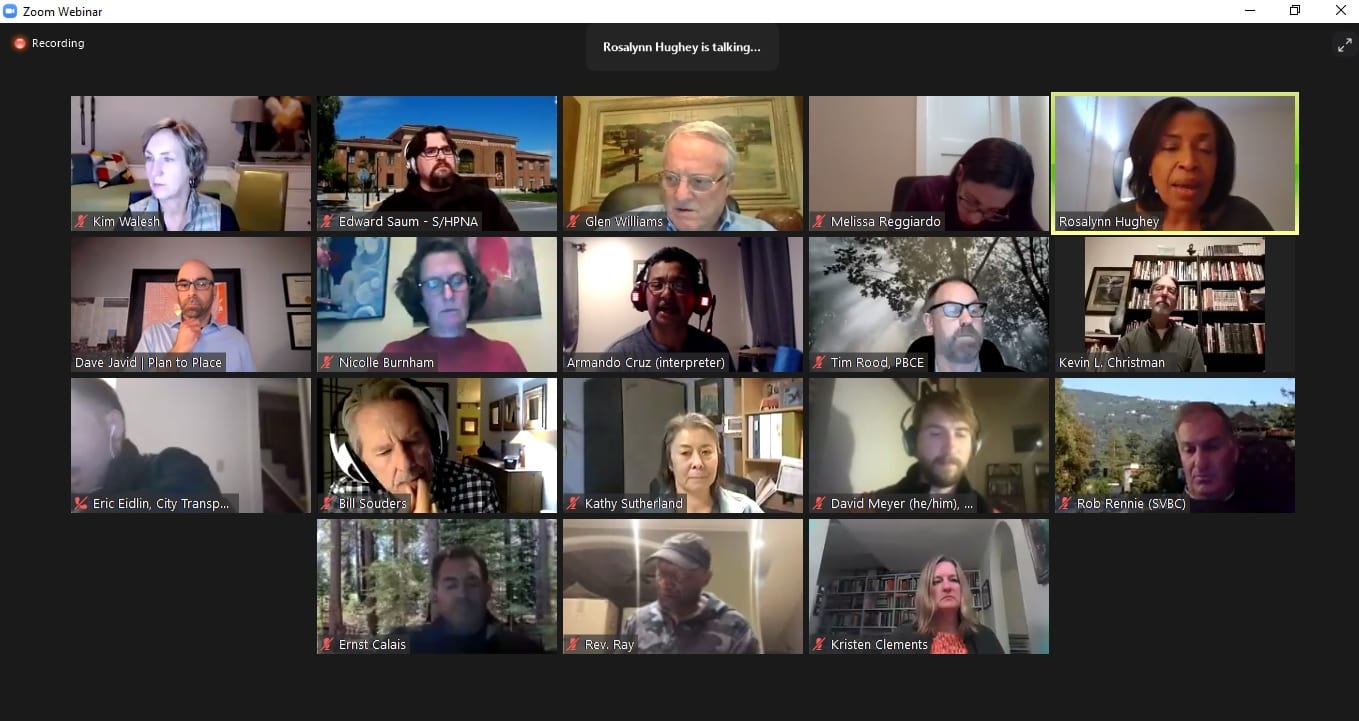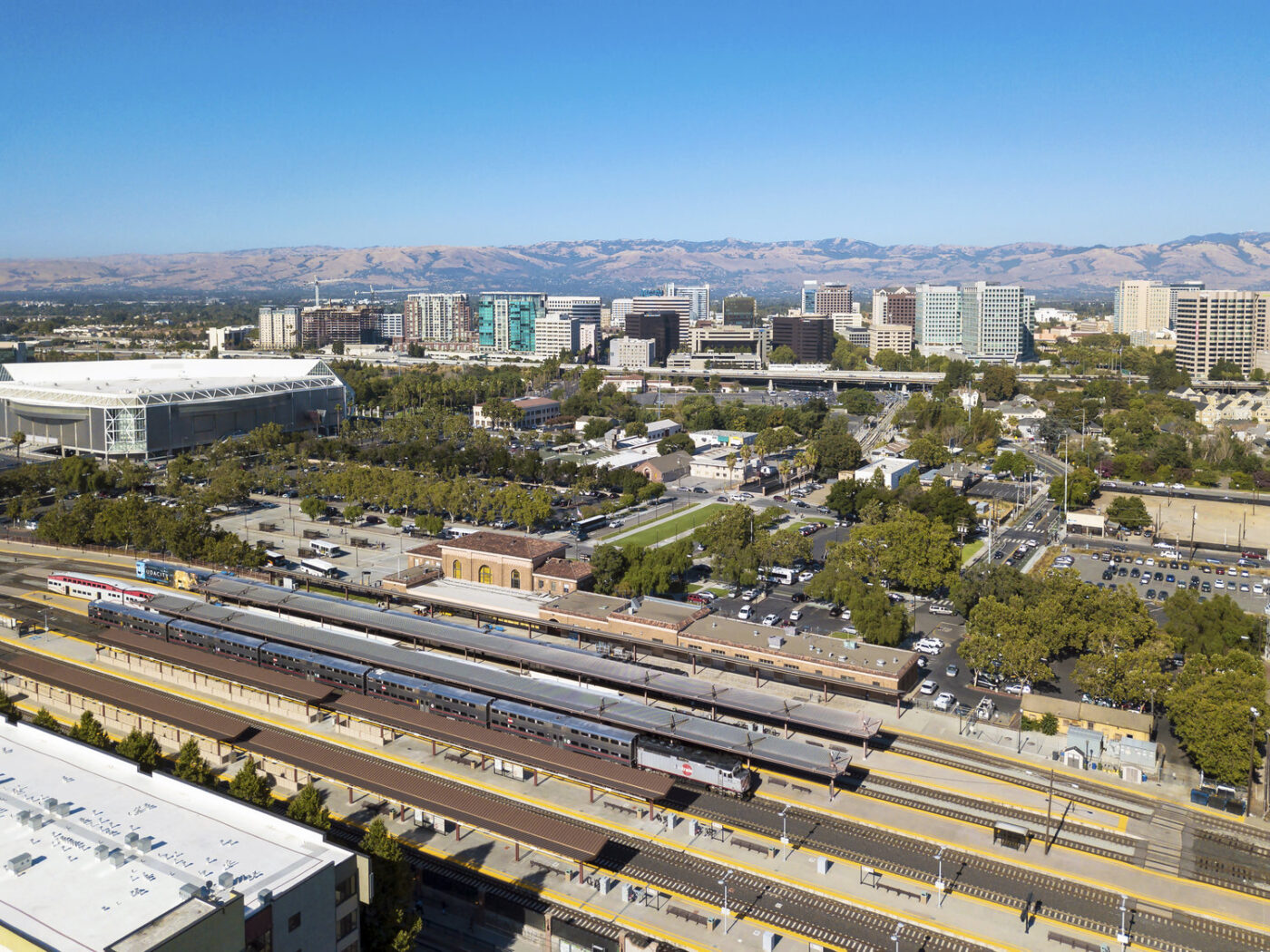David Meyer, director of strategic initiatives for SV@Home, said higher building limits would help the city meet its ambitious housing goal for the Diridon Station area. “We’re not here to speak against jobs,” Meyer said. “We need to be able to do high-rise development if we’re going to meet these targets.” Reducing planned building heights in the Diridon Station area could cause the city to lose capacity for hundreds of badly-needed homes.
BY: Sonya Herrera┃San Jose Spotlight
PUBLISHED: Nov 10, 2020
New apartments built near single-family homes should feature lots of green space — and better not rise too high.
These were the top concerns raised by members of the Diridon Station Area Advisory Group (SAAG) Monday night, as the group discussed San Jose’s plan for the 250-acre area, as well as Google’s proposed 80-acre campus project.
The 38-member SAAG — comprised of businesses, nonprofits, neighborhood associations and government agencies — has convened 18 times since 2018 to provide the city with feedback on development and transportation plans for the Diridon Station area. The group on Monday reviewed updates on Google’s 80-acre Downtown West plan, including 4,000 housing units, 7.3 million square feet of office space, 10 parks and a 30,000-50,000 square foot community center.
Details of the company’s updated plan were revealed last month and received mixed reviews from residents.
SAAG members and residents this week echoed those concerns, which include building heights. The latest draft of the Diridon Station Area Plan raises the high-rise limits to the FAA height limits, or roughly 300 feet. Mid-rise buildings could rise up to 130 feet while “transitional” buildings next to single-family homes could rise up to 90 feet.
Kathy Sutherland, a SAAG member representing the Diridon Area Neighborhood Group, said she doesn’t understand why the city is so focused on putting high-rises in the Diridon station area. She worries about towers rising next to single-family homes and whether they are economically feasible.
Nanci Klein, the city’s assistant economic development director, said most developers aren’t planning high-rises right now due to economic challenges.
“I don’t understand why everything is being forced into this one area,” Sutherland said. “Think about what really can be built, especially in areas of concern that are adjacent to existing neighborhoods.”
But SAAG member David Meyer, director of strategic initiatives for SV@Home, said higher building limits would help the city meet its ambitious housing goal for the Diridon Station area.
“We’re not here to speak against jobs,” Meyer said. “We need to be able to do high-rise development if we’re going to meet these targets.”
SAAG member Justin Wang, an advocate for urban planning nonprofit Greenbelt Alliance, said high-rises could hold the key to preventing displacement.
“This displacement is something that we can prevent if we build densely,” Wang said. “Height is necessary.”

SAAG member Harvey Darnell said building heights have risen higher and higher over the years.
“I’ve been involved in the General Plan since 2007, and we tried to make sure that all new development met fairly good interfaces with the existing neighborhoods,” he said.
Darnell added that the 19 acres of open space promised in the Diridon Station Area Plan fell short of what’s needed for an estimated 12,000 new housing units planned for the area. Following the guideline of 3.5 acres of parkland per 1,000 residents listed in the city’s General Plan, the city would need at least 42 acres of open space to accommodate the area’s new apartment residents.
“That’s just going to create slums,” Darnell said. “That just doesn’t create a good, vibrant city.”
SAAG members and residents also criticized the city’s lack of community outreach and approach to sharing the plans. Residents raised concerns that they were discouraged from sharing their opinions.
“I was expecting two minutes,” said Bill Rankin, president of the North Willow Glen Neighborhood Association. The meeting facilitator, Dave Javid of the community outreach firm Plan to Place, capped public comment to one minute, despite the fact that fewer than a dozen people commented.
Kevin Christman, a SAAG member representing the Gardner Neighborhood Association, said he was upset that Google was offering to build a community center in a city where existing community centers, such as Gardner Community Center, are closed.
“It makes my blood boil to the point to where it distracts me from the presentation,” Christman said. “We got our center put in here way back in the 60s because it was a way of buying off the neighborhood when they put (Highway) 280 in our neighborhood.”
Darnell agreed, adding the city is struggling to keep the centers running due to budget constraints.
Edward Saum, a SAAG member representing the Hanchett Park Neighborhood Association, suggested the meetings may have been designed to discourage public comment. “If I was cynical, I would say it’s a way to make sure not everyone can comment on what they would want to comment on,” Saum said.

San Jose resident Kathryn Hedges said she’s concerned that many pivotal decisions regarding the Google project have not fully engaged residents, such as when the City Council voted to sell city-owned land to the tech company in 2018.
“I’m very disturbed about the city selling the land to Google,” Hedges said. “This was not agreed upon by the residents of San Jose. This is our land, not (Mayor) Sam Liccardo’s.”
More public meetings on Google’s Downtown West Plan, as well as the city’s plan to develop up to 3,380 units of affordable housing in the Diridon Station area, are scheduled for this month. The next affordable housing meeting will be Nov. 12 at 5:45 p.m.
The City Council will have a study session on the Diridon Station Area Plan and Google’s Downtown West plan on Nov. 16.
Readers can review Google’s Downtown West plan documents and submit comments via this page. The deadline to comment on the Downtown West and Affordable Housing Implementation plans is Jan. 8.
The City Council plans to initiate a public hearing process and vote on the project sometime in Spring 2021.
Contact Sonya Herrera at sonya.m.herrera@gmail.com or follow @SMHsoftware on Twitter.
Photo: Sergio Ruiz

